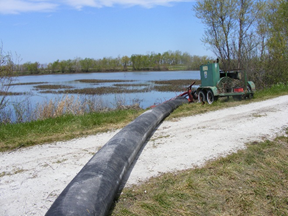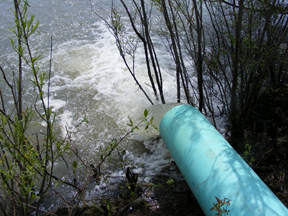April 5, 2018 | PAMF program staff

Figure 1: Water being pumped between pools at the USFWS Ottawa National Wildlife Refuge.
If you currently use water-level manipulation to manage Phragmites stands, or have the capability to do so, consider enrolling a unit in PAMF’s next annual cycle!
When it comes to habitat management, flooding can serve multiple purposes. Intentional manipulation of water levels can be used to promote several ecosystem functions and services, including wildlife habitat, plant diversity, invasive species control, storm water storage, nutrient retention, and water purification. Thus, it is no wonder that flooding management units is a management approach often supported by natural resource managers (Figure 1 and 2). At PAMF, we care about all these benefits, but there is only one that we monitor: controlling Phragmites invasions.
Phragmites has a remarkable adaptation for surviving in aquatic environments: it can snorkel! The average terrestrial plant becomes highly stressed in deep water as oxygen supplies are cut off from the plant’s tissues. Not so with Phragmites. In a recent webinar, Dr. Brian Sorrell of Denmark’s Aarhus University shared a fascinating discovery: Phragmites can set up a pressure-induced gas exchange in which both live and dead reeds are used to deliver oxygen to rhizomes covered in water (hence the term snorkeling). As long as part of the plant is above the water’s surface, it can maintain this convective gas flow and obtain the oxygen necessary for survival.
Although snorkeling is an impressive ability, managers can use this knowledge to inform water level adjustments that cut off Phragmites’ gas exchange. But how deep must the water be? How long should the water level be maintained at a certain depth? Must dead reeds be submerged as well? Unfortunately, a literature review on this subject revealed a shortage of studies that have rigorously researched flooding techniques under realistic field conditions. Best management practices offer divergent recommendations on flooding duration (six weeks to more than a year) and depth (six inches to nearly five feet, often without reference to plant height). There is general agreement, however, that the growing season is the best time to use flooding to inhibit Phragmites because that is when the plant is most in need of precious oxygen.

Figure 2: Water outflow at Ottawa River National Wildlife Refuge
PAMF includes flooding as one of the possible management actions that land managers can use for our program. Given the lack of consensus regarding certain aspects of an effective flood regime, PAMF has adopted a very broad definition—the Flood management action refers to allowing water to cover all live Phragmites within the whole management unit for a certain period of time. Even natural floods that cover all live tissue qualify, and we leave the flood duration and depth to the manager’s discretion. In addition, a few of our management alternatives include a flood that is preceded by Pre-Flood Clearing (i.e., all dead reeds within the unit are mechanically leveled). Lower water levels that do not cover all live Phragmites tissue are considered “wet” hydrology, rather than full-fledged flooding. By tracking these relevant details, participants can help PAMF determine each factor’s contribution to the flood’s effectiveness and reduce the uncertainties around which flooding regime is optimal.
Adaptive management is intended to evaluate multiple management actions to establish which is most effective in achieving programmatic goals. As the Phragmites Adaptive Management Framework, we monitor Phragmites management responses throughout the Great Lakes basin to determine which management actions, including flooding, work best under different conditions. However, to ensure reliable evaluation of management outcomes, PAMF is working to communicate management action definitions to all participants as clearly as possible. Unless management actions are applied consistently across all enrolled management units, a flood may not always be a Flood.
On that note, PAMF is limited by the variety of currently enrolled management units, as few sites have the capacity to manipulate water levels. Therefore, to minimize skewed data and maximize our programmatic reach, we need units where flooding is a possible means of Phragmites control. As stated earlier, please consider enrolling a unit in PAMF’s next annual cycle if you currently use or have the capability to use water-level manipulation to manage Phragmites stands.
